Since the publication of Bob Woodward’s book Obama’s Wars, criticism has grown of an administration that is supposedly mired in controversy and backbiting over the conduct of the conflict in Afghanistan. The president, too, has been seen as lacking in conviction. To paraphrase one adviser, it sometimes seems the president is going through the motions, perhaps approving Gen. Stanley McChrystal’s troop buildup plan last fall only to be able to say that he gave it the old college try come July 2011. That’s the date when Obama has promised a major strategy review as well as the beginning of the troop drawdown.
Obama has conveyed mixed messages on the war. As a result, key constituencies — such as elements of the Pakistani intelligence services — anticipate a rapid American departure next summer, and it can hurt us on the battlefield. But otherwise, critics are missing the central reality, that the president has been quite solid in his conduct of this important war.
We must not lose sight of this core fact: Obama has tripled U.S. combat forces in Afghanistan. The U.S. government civilian presence there has also tripled on Obama’s watch, and total foreign aid is now $4 billion a year, the largest such American program in the world. The intended length of the troop buildup, while possibly too short, nonetheless would be comparable to the length of time that the Iraqi surge endured under President Bush. The administration’s overall messaging about its plans for 2011, while perhaps transfixed on the July drawdown, has studiously avoided any promises about how rapidly forces would leave.
Three assurances
As Woodward’s book reveals, Obama was dubious about McChrystal’s proposal for more troops in the major policy review last fall, and ultimately granted the Pentagon fewer than requested. But there are three good reasons to be reassured by what Woodward reports:
- Obama did approve most of McChrystal’s request, and we now have 100,000 U.S. troops in Afghanistan as a result. He did so despite objections from retired military officers serving in his White House, including, it appears, the outgoing national security adviser.
- Since the Pentagon had only a few months before suggested that a 68,000 U.S. troop level would be adequate, Obama could be forgiven for a bit of skepticism and a desire to be sure his policies toward Afghanistan were not beginning to echo those of President Johnson over the Vietnam War. As such, the three-month delay in decision-making was reasonable.
- There was a legitimate logic for shortchanging the full McChrystal request in the interest of eliciting greater allied help — which has, to some extent, subsequently been obtained.
We also need to understand Woodward’s books for what they are — essentially well informed high-level political soap opera. The fact that some unflattering images of various administration officials might have emerged is hardly a damning indictment. After all, administration officials were debating policy options in a war that was already eight years old and going south. Asking the occasional tough question is part of the job. And fallible humans in high-pressure situations often say unflattering things about each other — especially to Woodward.
All that said, the administration does have a challenge of perceptions. Much of the world does not see a studious and solid wartime leader in Obama. That’s hurting him. As American critics grow increasingly convinced that we need a Plan B — with the most popular fallback option consisting of major and rapid U.S. troop withdrawals, a pullback of remaining forces to Kabul and points north, and nothing more than standoff counterterrorism strikes against targets in the country’s vast south and east — many players in this conflict believe that the U.S. will rapidly minimize its commitment next summer, which leads them to hedge bets harmfully on the battlefield.
What would a quick pullback leavebehind? A Taliban takeover of at least the Pashtun south would likely result, creating threats to Kabul as well as possible sanctuaries for everyone from al-Qaeda to the Pakistani Taliban. Attacks by drones as well as commando raids by U.S. special forces could hardly hope to prevent these consequences, especially with the ensuing loss of human intelligence in the region. (Because our friends would be largely killed off or otherwise silenced after we left.)
A need for clarity
Obama showed no sympathy for such a Plan B in his policy review last fall, and he should say so today. He also should clarify two things: One, that he is more committed to Plan A than his critics seem to understand. The best proof of this is the 100,000 U.S. troops in Afghanistan. And two, that any fallback plan would not be the minimalist version commonly promoted today. It would be a Plan A-minus rather than a Plan B, carefully phasing down NATO troops as Afghan forces improve in the coming years, implying a two-to-four year transition. My recent trip to Afghanistan provided good reason to believe that our training and partnering program for those Afghan forces is starting to work, so this is a serious alternative.
Going forward, President Obama’s actions in the Afghanistan war will speak much louder than any words — even if the words come from a source as revered as Bob Woodward.


Commentary
Op-edAn Obama Story Bob Woodward Doesn’t Tell
October 12, 2010